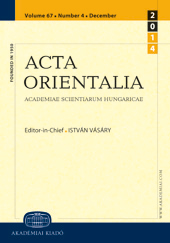T1G2 in the Ongi Inscription
T1G2 in the Ongi Inscription
Author(s): Li Yong-SŏngSubject(s): Historical Linguistics, Translation Studies
Published by: Akadémiai Kiadó
Keywords: Old Turkic script; Ongi Inscription; Orkhon inscriptions; Orkhon Turkic; Turkic; dí 敵
Summary/Abstract: The word T1G2 occurs three times in the Ongi Inscription. The sentences containing T1G2 have been interpreted in a variety of ways, with no single reading thus far being deemed satisfactory. A notable aspect of the Old Turkic script is the presence of two distinct characters for the majority of consonant sounds, one representing a back-vocalic and the other a front-vocalic sign. Given that T1G2 occurs on three occasions, it is plausible that the individual(s) responsible for inscribing the text may have deliberately employed this format. The author hypothesizes that T1G2 in question represents the Turkic rendering of the Chinese character dí 敵, which translates to “enemy; hostile.”
Journal: Acta Orientalia Academiae Scientiarum Hungaricae
- Issue Year: 77/2024
- Issue No: 3
- Page Range: 399-414
- Page Count: 16
- Language: English
- Content File-PDF

